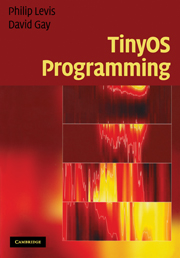Book contents
- Frontmatter
- Contents
- List of Code examples
- Preface
- Acknowledgements
- Programming hints, condensed
- Part I TinyOS and nesC
- Part II Basic programming
- 3 Components and interfaces
- 4 Configurations and wiring
- 5 Execution model
- 6 Applications
- 7 Mote-PC communication
- Part III Advanced programming
- Part IV Appendix and references
- References
- Index
7 - Mote-PC communication
Published online by Cambridge University Press: 05 August 2012
- Frontmatter
- Contents
- List of Code examples
- Preface
- Acknowledgements
- Programming hints, condensed
- Part I TinyOS and nesC
- Part II Basic programming
- 3 Components and interfaces
- 4 Configurations and wiring
- 5 Execution model
- 6 Applications
- 7 Mote-PC communication
- Part III Advanced programming
- Part IV Appendix and references
- References
- Index
Summary
This chapter shows how to build a PC application that talks to motes. As we saw in Section 6.4, a PC typically interacts with a mote network by exchanging packets with a distinguished base station mote (occasionally, several motes) over a serial connection (Figure 6.2, page 95). The PC code in this chapter is written in Java, using the Java libraries and tools distributed with TinyOS. TinyOS also includes libraries and tool support for other languages (e.g. C). Please refer to the TinyOS documentation for more information on these other languages. The TinyOS Java code for communicating with motes is found under the net.tinyos package.
Basics
At the most basic level, PCs and motes exchange packets that are simply sequences of bytes, using a protocol inspired by, but not identical to, RFC 1663 [24] (more details on the protocol can be found in TEP 113 [7]). This packet exchange is not fully reliable: the integrity of packets is ensured by the use of a CRC, but invalid packets are simply dropped. Furthermore:
Packets sent from a PC to a mote are acknowledged by the mote (but there is no retry if no acknowledge is received) – this prevents the PC from overloading the mote with packets.
Packets sent from a mote to a PC are not acknowledged.
While it is possible to write mote communication code by reading and writing the raw bytes in packets, this approach is tedious and error-prone. Furthermore, any changes to the packet layout (e.g. adding a new field, changing the value of a constant used in the packets) requires corresponding changes throughout the code.
- Type
- Chapter
- Information
- TinyOS Programming , pp. 112 - 126Publisher: Cambridge University PressPrint publication year: 2009

